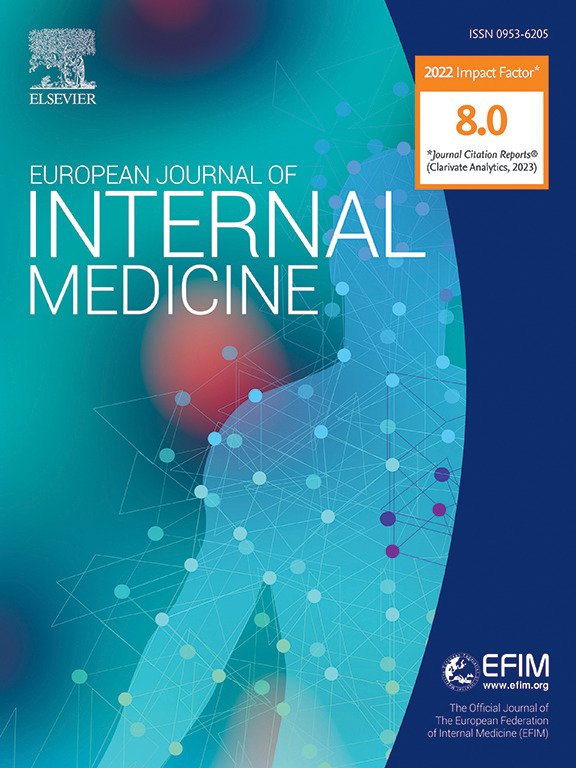Association of miR-126-3p, miR-1260b and miR-374a-5p with the incidence of heart failure in a population-based cohort: the Hortega Follow-Up Study
IF 5.9
2区 医学
Q1 MEDICINE, GENERAL & INTERNAL
引用次数: 0
Abstract
Background
Circulating microRNAs (miRNAs) are emerging markers for cardiovascular prevention and control. miRNAs associated to vascular damage are candidates to play a causal role in the microvascular dysfunction of heart failure (HF). The aim was to evaluate the observational and causal (Mendelian randomization) association of miRNAs related with vascular alterations (miR-126–3p, miR-1260b and miR-374a-5p) with HF incidence in a sample from the general population.
Methods
Plasma miRNAs levels were measured in 985 Hortega Study participants using real time quantitative polymerase chain reaction (RT-qPCR). Single nucleotide polymorphisms (SNPs) were genotyped with the TOPMED imputable Illumina GSA array. We identified genetic instrumental variables for miR-126–3p (33 SNPs), miR-1260b (22 SNPs) and miR-374a-5p (35 SNPs) and run several Mendelian randomization approaches.
Results
The hazard ratio (95 % confidence interval) of HF by a 10-fold increase in miR-126–3p, miR-1260b and miR-374a-5p was 1.53 (1.09, 2.14), 1.38 (1.03, 1.86), and1.30 (1.09, 1.57), respectively. The corresponding rate differences were 9.7 (-0.1, 19.5), 12.0 (0.4, 23.6) and 9.1 (1.2, 17.1) per 10000 person-years. In flexible dose-response analysis, increased miRNAs levels were associated with higher HF risk, both in the relative and additive scale. In Mendelian randomization analysis, consistently suggestive positive causal associations were found with HF for increased miR-126–3p and miR-1260b levels, but not for miR-374a-5p.
Conclusions
In observational analysis, miR-126–3p, miR-1260b and miR-374a-5p levels were positively associated with HF incidence. Mendelian randomization analysis supported a causal role for miR-126–3p and miR-1260b, thus suggesting a potential use as prognostic and therapeutic targets for HF prevention and control.

在以人群为基础的队列中,miR-126-3p、miR-1260b和miR-374a-5p与心力衰竭发病率的关联:Hortega随访研究
背景:循环microRNAs (miRNAs)是心血管疾病预防和控制的新兴标志物。与血管损伤相关的mirna是在心力衰竭(HF)微血管功能障碍中发挥因果作用的候选者。目的是评估与血管改变相关的mirna (miR-126-3p, miR-1260b和miR-374a-5p)与普通人群中HF发病率的观察性和因果关系(孟德尔随机化)。方法:使用实时定量聚合酶链反应(RT-qPCR)检测985名Hortega研究参与者的血浆miRNAs水平。使用TOPMED可植入Illumina GSA阵列对单核苷酸多态性(snp)进行基因分型。我们确定了miR-126-3p(33个snp)、miR-1260b(22个snp)和miR-374a-5p(35个snp)的遗传工具变量,并运行了几种孟德尔随机化方法。结果:miR-126-3p、miR-1260b和miR-374a-5p增加10倍导致HF的风险比(95%置信区间)分别为1.53(1.09,2.14)、1.38(1.03,1.86)和1.30(1.09,1.57)。相应的发病率差异分别为9.7(-0.1,19.5)、12.0(0.4,23.6)和9.1(1.2,17.1)/ 10000人年。在灵活的剂量反应分析中,增加的mirna水平与较高的HF风险相关,无论是相对规模还是累加规模。在孟德尔随机化分析中,一致提示与HF呈正相关的miR-126-3p和miR-1260b水平升高,但与miR-374a-5p无关。结论:在观察性分析中,miR-126-3p、miR-1260b和miR-374a-5p水平与HF发病率呈正相关。孟德尔随机化分析支持miR-126-3p和miR-1260b的因果作用,从而提示其可能作为心衰预防和控制的预后和治疗靶点。
本文章由计算机程序翻译,如有差异,请以英文原文为准。
求助全文
约1分钟内获得全文
求助全文
来源期刊
CiteScore
9.60
自引率
6.20%
发文量
364
审稿时长
20 days
期刊介绍:
The European Journal of Internal Medicine serves as the official journal of the European Federation of Internal Medicine and is the primary scientific reference for European academic and non-academic internists. It is dedicated to advancing science and practice in internal medicine across Europe. The journal publishes original articles, editorials, reviews, internal medicine flashcards, and other relevant information in the field. Both translational medicine and clinical studies are emphasized. EJIM aspires to be a leading platform for excellent clinical studies, with a focus on enhancing the quality of healthcare in European hospitals.

 求助内容:
求助内容: 应助结果提醒方式:
应助结果提醒方式:


